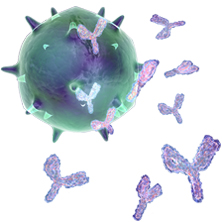Dhakad AK, Pandey VV, Beg S, Rawat JM Journal of the Science of Food and Agriculture, 2017 ABSTRACT: The genus Eucalyptus L’Heritier comprises about 900 species, of which more than 300 species contain volatile essential oil in their leaves. About 20 species, within these, have a high content of 1,8-cineole (more than 70 %), commercially used for the… Read more »

This system includes the lymph nodes, white blood cells, lymphatic vessels, thymus gland, bone marrow, spleen and leukocytes. Common disorders include anything with bacterial, viral or fungal origins, leukemia, allergic reactions and autoimmune diseases like lupus or rheumatoid arthritis.
Inhibition of Salmonella by thyme essential oil and its effect on microbiological and sensory properties of minced pork meat packaged under vacuum and modified atmosphere
Boskovic M, Djordjevic J, Ivanovic J, Janjic J, Zdravkovic N, Glisic M, Glamoclija N, Baltic B, Djordjevic V, Baltic M International Journal of Food Microbiology, 2017 ABSTRACT: The antibacterial activity of thyme essential oil (TEO) was evaluated against four serovars of Salmonella (S. Enteritidis, S. Typhimurium, S. Montevideo and S. Infantis), experimentally inoculated (106CFU/g) in minced pork, which was treated with different concentrations of the… Read more »
Thymus vulgaris L. and thymol assist murine macrophages (RAW 264.7) in the control of in vitro infections by Staphylococcus aureus, Pseudomonas aeruginosa, and Candida albicans
de Oliveira JR, Figueira LW, Sper FL, Meccatti VM, Camargo SEA, de Oliveira LD Immunologic Research, 2017 ABSTRACT: Microorganisms are capable to combat defense cells by means of strategies that contribute to their stabilization and proliferation in invaded tissues. Frequently antimicrobial-resistant strains appear; therefore, alternative methods to control them must be investigated, for example, the use of plant products. The… Read more »
Interaction of human telomeric G-quadruplex DNA with thymoquinone: a possible mechanism for thymoquinone anticancer effect
Salem AA, El Haty IA, Abdou IM, Mu Y Biochimica et Biophysica Acta, 2015 ABSTRACT: BACKGROUND: Thymoquinone (TQ) has been documented to possess chemo-preventive and chemotherapeutic antitumor effects. Studies reported that TQ inhibits the growth of cancer cells in animal models, culture and xenografted tumors. Molecular mechanisms underlying these anticancer effects were attributed to inductions of cell cycle arrest,… Read more »
Thymoquinone induces telomere shortening, DNA damage and apoptosis in human glioblastoma cells
Gurung RL, Lim SN, Khaw AK, Soon JF, Shenoy K, Mohamed Ali S, Jayapal M, Sethu S, Baskar R, Hande MP PloS One, 2010 ABSTRACT: BACKGROUND: A major concern of cancer chemotherapy is the side effects caused by the non-specific targeting of both normal and cancerous cells by therapeutic drugs. Much emphasis has been placed on discovering new compounds that target tumour cells more… Read more »
Anethole Inhibits The Proliferation Of Human Prostate Cancer Cells Via Induction Of Cell Cycle Arrest And Apoptosis
Elkady AI Anti-Cancer Agents in Medicinal Chemistry, 2017 ABSTRACT: BACKGROUND: Prostate cancer-associated mortality is increasing at an alarming rate, which highlights the inevitability for unearthing novel agent for the management of this disease. Anethole, a major constituent of Foeniculum vulgare (fennel) essential oil, is widely used in folk medicine; it possesses anti-oxidant, anti-inflammatory, anti-proliferative and tumoricidal potentialities…. Read more »
Effect of cinnamon (Cinnamomum verum) bark essential oil on the halitosis-associated bacterium Solobacterium moorei and in vitro cytotoxicity
LeBel G, Haas B, Adam AA, Veilleux MP, Lagha AB, Grenier D Archives of Oral Biology, 2017 ABSTRACT: OBJECTIVES: Halitosis, also known as bad breath or oral malodour, is a condition affecting a large proportion of the population. Solobacterium moorei is a Gram-positive anaerobic bacterium that has been specifically associated with halitosis. In this study,… Read more »
Evaluating the antimicrobial potential of green cardamom essential oil focusing on quorum sensing inhibition of Chromobacterium violaceum
Abdullah, Asghar A, Butt MS, Shahid M, Huang Q Journal of Food Science and Technology, 2017 ABSTRACT: Spices are well known for their taste and flavor imparting properties. Green cardamom (Elletaria cardamomum), a herb spice belongs to family Zingiberaceae. In current study, GC-MS analysis of green cardamom essential oil (CEO) resulted in identification of twenty-six compounds with α-terpinyl acetate (38.4%), 1,8-cineole (28.71%), linalool… Read more »
Potential protective effects of alpha-pinene against cytotoxicity caused by aspirin in the IEC-6 cells
Bouzenna H, Hfaiedh N, Giroux-Metges MA, Elfeki A, Talarmin H Biomedicine & Pharmacotherapy, 2017 ABSTRACT: Alpha-pinene is a key compound of the essential oils extracted from many species of coniferous trees. It is known for its biological activities. The aim of the present study was to determine the preventive effect of alpha-pinene on aspirin-induced toxicity in vitro, using IEC-6 cells, and… Read more »
Eucalyptol, sabinene and cinnamaldehyde: potent inhibitors of salmonella target protein L-asparaginase
Vimal A, Pal D, Tripathi T, Kumar A 3 Biotech, 2017 ABSTRACT: Salmonella typhimurium is a severe threat to human life. The treatment became more difficult with the emergence of multidrug resistance. In the present in silico study, a novel drug target L-asparaginase was tested against three ligands eucalyptol, sabinene, and cinnamaldehyde, major components of cardamom, nutmeg, and cinnamon, respectively…. Read more »
